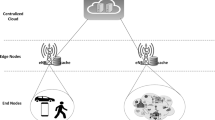Abstract
This paper proposes a novel mobile multimedia content handoff scheme for a content delivery network (CDN) based on proxy mobile IPv6 (PMIPv6). PMIPv6 is a network-based mobility management protocol. In PMIPv6, when a mobile node (MN) that is currently receiving content from one domain moves into neighboring domain, it can maintain its existing session seamlessly. However, when the MN moves continuously, the content delivery path may become long, potentially leading to heavy network traffic and degradation of the quality of service (QoS) through delay and jitter. The proposed handoff scheme (PMIPv6-CDN Handoff) selects an optimal content server as a mobile node (MN) moves in a handoff and receives content. This scheme offers several benefits such as routing path optimization and a reduced transmission delay. Therefore, it can be applied to virtual reality (VR) and augmented reality (AR) services, which are sensitive to transmission delay.












Similar content being viewed by others
References
Augmented Reality, https://en.wikipedia.org/wiki/Augmented_reality. Accessed 14 April 2018.
Chung JM, Lee D, Song WJ, Choi S, Lim C, Yeoum T (2013) Enhancements to FPMIPv6 for improved seamless vertical handover between LTE and heterogeneous access networks. IEEE Wirel Commun 20(3):112–119. https://doi.org/10.1109/MWC.2013.6549290
Dilley J, Maggs B, Parikh J, Prokop H, Sitaraman R, Weihl B (2002) Globally distributed content delivery. IEEE Internet Comput 6:50–58. https://doi.org/10.1109/MIC.2002.1036038
Elbamby MS, Perfecto C, Bennis M, Doppler K (2018) Toward low-latency and ultra-reliable virtual reality. IEEE Netw 32(2):78–84. https://doi.org/10.1109/MNET.2018.1700268
Gundavelli, S., Leung, K., Devarapalli, V., Chowdhury, K., & Patil, B. (2008). Proxy mobile ipv6 (No. RFC 5213).
Irwin L, William T (2001) Exploring content delivery networking. IT Professional 3:47–49. https://doi.org/10.1109/6294.946620
Kideok C, Hakyung J, Munyoung L, Diko K, Kwon TT, Yanghee C (2011) How can an ISP merge with a CDN? IEEE Commun Magazine 49:156–162. https://doi.org/10.1109/MCOM.2011.6035830
Kim T, Kim E-J (2015) View pattern-based adaptive streaming strategy for mobile content delivery services. Multimed Tools Appl 75:12693–12704. https://doi.org/10.1007/s11042-015-3077-4
Kim T, Kim E-J (2015) Hybrid storage-based caching strategy for content delivery network services. Multimed Tools Appl 74:1697–1709. https://doi.org/10.1007/s11042-014-2215-8
Kim T, Li C, Yim T, Kim Y, Kim M, Park J (2014) Novel architecture for a mobile content delivery network based on proxy mobile IPv6. IEICE Trans Fundam Electron Commun Comput Sci 97(3):907–910
Kong KS, Lee W, Han YH, Shin MK, You H (2008) Mobility management for all-IP mobile networks: mobile IPv6 vs. proxy mobile IPv6. IEEE Trans Wireless Communications 15:36–45. https://doi.org/10.1109/MWC.2008.4492976
Kurose J, Ross K (2013) Multimedia networking. In: Hirsch M (ed) Computer networking: a top-down approach, 6th edn. Pearson, New Jersey, pp. 588–592.
Lai, Z., Hu, Y. C., Cui, Y., Sun, L., & Dai, N. (2017). Furion: Engineering High-Quality Immersive Virtual Reality on Today's Mobile Devices. In Proceedings of the 23rd Annual International Conference on Mobile Computing and Networking (pp. 409–421). ACM.
Lee J, Bonnin J, You I, Chung T (2013) Comparative handover performance analysis of IPv6 mobility management protocols. IEEE Trans Ind Electron 60(3):1077–1088. https://doi.org/10.1109/TIE.2012.2198035
Rajknmar B, Mukaddim P, Athena V (2008) Content delivery networks: state of the art, insights, and imperatives. In: Content delivery networks, 1st edn, Springer-Verlag berlin Heidelberg, pp. 3–32.
Soto I, Bernardos CJ, Calderón M, Melia T (2010) PMIPv6: A Network-Based Localized Mobility Management Solution. IPJ. 1–32.
Sun L, Zhou Y, Hansen P, Geng W, Li X (2018) Cross-objects user interfaces for video interaction in virtual reality museum context. Multimed Tools Appl 77:29013. https://doi.org/10.1007/s11042-018-6091-5
Tian Y, Wang X, Yao H, Chen J, Wang Z, Yi L (2018) Occlusion handling using moving volume and ray casting techniques for augmented reality systems. Multimed Tools Appl 77:6561. https://doi.org/10.1007/s11042-017-5228-2
Vakali A, Pallis G (2003) Content delivery networks: status and trends. IEEE Internet Comput 7:68–74. https://doi.org/10.1109/MIC.2003.1250586
Verma DC (2003) Overview of content distribution networks. In: Content distribution networks: an engineering approach, 1st edn, New York: John Wiley & Sons, Inc., USA, pp.1–24.
Virtual Reality, https://en.wikipedia.org/wiki/Virtual_reality. Accessed 14 April 2018.
Acknowledgments
This Research was supported by the Tongmyong University Research Grants 2016(2016A001).
Author information
Authors and Affiliations
Corresponding author
Additional information
Publisher’s note
Springer Nature remains neutral with regard to jurisdictional claims in published maps and institutional affiliations.
Rights and permissions
About this article
Cite this article
Kim, TK. A mobile multimedia content handoff scheme based on proxy mobile IPv6 for VR/AR. Multimed Tools Appl 79, 16501–16515 (2020). https://doi.org/10.1007/s11042-019-7573-9
Received:
Revised:
Accepted:
Published:
Issue Date:
DOI: https://doi.org/10.1007/s11042-019-7573-9




